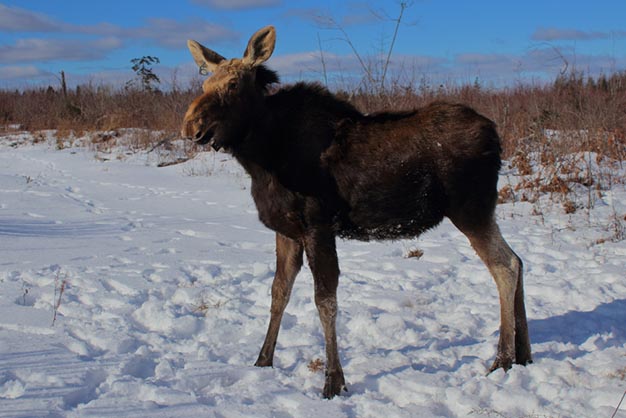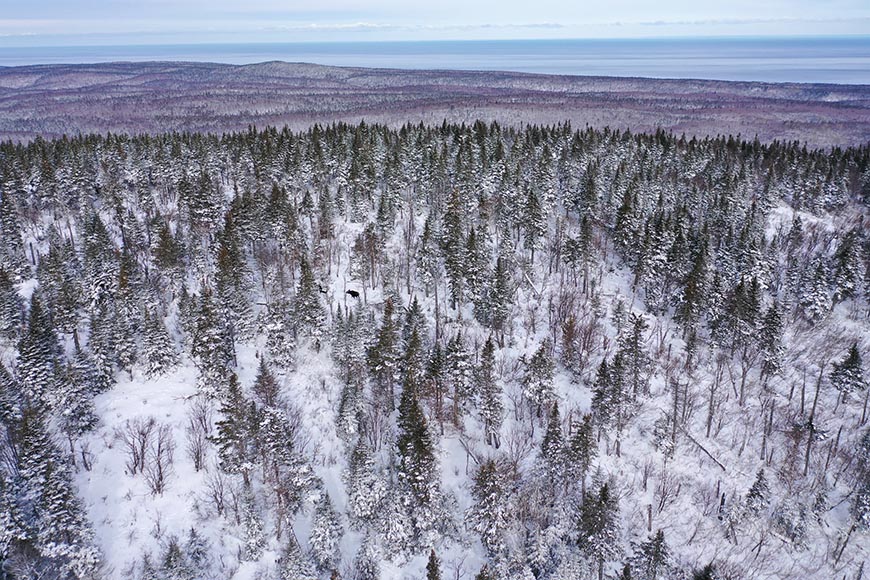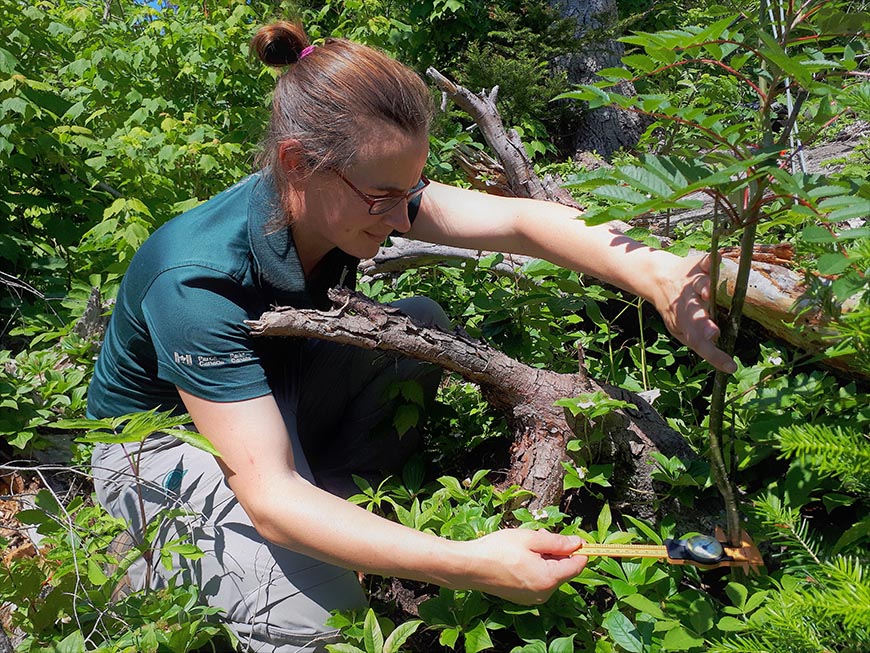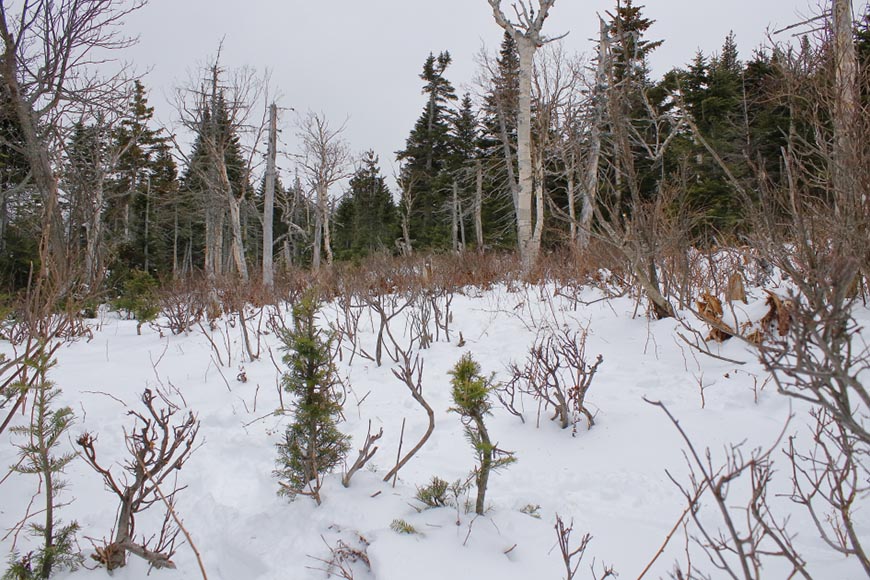
Moose - Maintaining forest balance
Forillon National Park
The moose fascinates. Its stature imposes. It is the largest of the cervid family. It is possible to see a moose in Forillon National Park with a little luck, knowledge of its habits, patience and a good dose of discretion.
Although discreet, moose are numerous in the park. Their number exceeds what a healthy, balanced forest can usually support.
The Natural Resources Conservation team came to this conclusion through
- regular monitoring of the park's moose population;
- habitat monitoring;
- scientific research results obtained over the last 15 years.
Management has adopted a 5-year management plan in 2023. This plan aims to protect the forest of Forillon National Park and all the animal species that depend on it for shelter, food and reproduction.
Hyperabundant Moose Management Plan 2023 - 2027
The management plan takes stock of the state of the moose population and the park’s ecological integrity. It contains recommendations and measures based on scientific findings and public consultations. The conservation hunting, as described in the management plan, is not being considered in the short term.
How many moose are there currently?
The first estimations carried out after the park was created identified approximately 50 moose. Thereafter, the population remained between 100 and 150 individuals until a significant increase was noted in 2009. In 2017, over 840 moose populated the park, which is approximately 35 moose per 10 km2.
Monitoring Data from 1997 to 2017 (Open Government) The monitoring data will soon be made available on the Government website.
According to the 2023 data aerial inventory, the moose population in Forillon National Park numbers about 530 individuals, or 22 animals per 10 km2.
With the variations in moose numbers, Parks Canada is increasing the frequency of data collection to monitor both moose and their impact on the park’s forest.
Why the decline in the moose population?
All wildlife populations are likely to experience declines and increases in their numbers at different times in their existence. Variations are part of natural phenomena.
At this time, there is no certainty about what caused the observed decline in the moose population.
Most important now is to apply our research program to identify the medium-term trend and the multiple probable causes of variations in the moose population over time.
Are there too many moose?
Prior research estimates that to maintain a long-term balance, an environment such as Forillon National Park should have between 10 and 20 moose per 10 km2.
At 22 moose per 10 km2, the moose population is approaching the level of abundance that would maintain the balance of the forest, but remains high.
A lot of moose — is this a problem?
Moose are large herbivores that eat between 10 and 30 kg of vegetation per day. They are capable of changing the composition and abundance of the plant species they consume. In densely populated areas, moose can alter vegetation to the point of changing the dynamics of forest regeneration and transforming young forests into prairies. In this case, there is no prospect of regaining a woodland habitat in the short-term.
At this stage, the survival of some animal species may also be affected such
- as Bicknell’s thrush, an at-risk species;
- the American pine marten that depends on the presence of mature forests;
- the Canada lynx.
Due to its impact on forest regeneration and biodiversity, a hyperabundance of moose can threaten the integrity of an entire ecosystem.
Why are there so many moose?
There are so many moose in the park essentially because of the absence of population-regulating factors.
- Wolves—their main predator—disappeared from the region over 100 years.
- Bears and coyotes are generally not predators that are likely to influence the moose population abundance in a significant way.
- Hunting is prohibited.
- Diseases and parasites have little impact.
- The last spruce budworm epidemic rejuvenated forest stands, creating more food for the moose population as a result.
In fact, the park’s moose live a peaceful life and have no issues finding food.
What is a management plan?
Once a population is considered “overabundant,” as is the case for moose in Forillon National Park, the Agency puts in place an approach to maintain the health of the ecosystems.
As part of the "Maintaining Forest Balance" project, the Hyperabundant Moose Management Plan 2023 - 2027 is divided into 2 main components:
- knowledge acquisition;
- control measures.
A major research program
Forillon National Park has undertaken a major research program to acquire new knowledge about moose.
With the variations in moose numbers, Parks Canada is increasing the frequency of data collection to monitor both moose and their impact on Forillon National Park's forest.
This 4 pronged program serves as a guide for making informed decisions.
1. Studying the dynamics of the moose population in Forillon National Park

With the Université du Québec à Rimouski, Park Canada is developing a mathematical tool to predict how the moose population varies over time, based on parameters that influence
- deaths,
- births,
- the entry and exit of moose from the park.
Fertility of females, birth rates and survival of calves
With Université Laval, Parks Canada is currently studying fertility, birth rates and summer survival of calves, and assessing the importance of black bear predation.
Abondance monitoring
Surveys are a very effective method of tracking moose population trends. The most recent inventories were conducted in 2023.
Surveys enable us to estimate:
- the population;
- the number of moose/km2;
- the number of males, females and calves, etc.
At Forillon National Park, inventories are conducted in 2 ways:
- by helicopter;
- by camera.
Helicopter inventories are the more "traditional" method. Camera inventories are complementary and are conducted from the ground. They are used for both black bears and moose.
2. Studying the winter tick's effect on the health of the king of our forests

The winter tick is tiny. However, it can significantly affect a moose population by reducing the survival of the most affected individuals. For this reason, it requires its own research component.
Université Laval (Professor Jean-Pierre Tremblay), the Ministère des Forêts, de la Faune et des Parcs, and their various partners, including Parks Canada, have developed a cooperative research and development project on the role of the winter tick in the ecology of moose populations in Eastern Canada.
Since winter 2020, 60 radio collars have been fitted to 29 adult females and 31 calves. Winter 2023 was the last winter for the installation of radio collars.
The radio collars fall to the ground automatically due to a programmable mechanism.
They are found through the tracker and are collected once they have fallen to the ground.
The data transmitted by the radio collars provide information on:
- moose movements;
- the areas they frequent;
- their survival;
- indirect causes of death.
3. Detecting the impacts of moose on ecosystems

The results of research conducted since the previous moose management plan (2013) show that moose affect forest regeneration. The impact varies by area. Mountain peaks appear to be more severely affected than the rest of the territory (2019).
Parks Canada combines satellite image data with data from radio collars. The results of this study could provide an overview of the impacts of moose in the park and help identify the areas most at risk of disturbance.
4. Understanding the impacts of the moose on the ecosystems

Unlike a paddock, the eight exclosures, each measuring 400 m2 and located in the park, keep the moose outside the fenced area and prevent them from eating the vegetation.
An exercise to count the branches of trees and shrubs, grazed or not by a particular species, is called a browse inventory. It provides information on the quantity and quality of food available for moose.
This allows us to compare the vegetation in the exclosures with the one in control sites—same size marked out areas where vegetation is still accessible. This comparison allows us to assess the impacts of the moose on the vegetation.

Browse inventories are also carried out in yarding area, where cervid confine themselves in winter.
Browse inventories were conducted in the exclosures and yarding area in 2023.
Is this a unique situation?
There are other national parks in Eastern Canada facing the same issue, some of them have been dealing with a hyperabundance of moose for over 25 years. All of them have taken measures to control the moose population and to protect or restore forests.
The Forillon National Park research project is inspired by the best practices developed in similar projects carried out in Cape Breton Highlands, Gros Morne and Terra Nova national parks.
Do you have any questions or comments on this subject?
- Date modified :